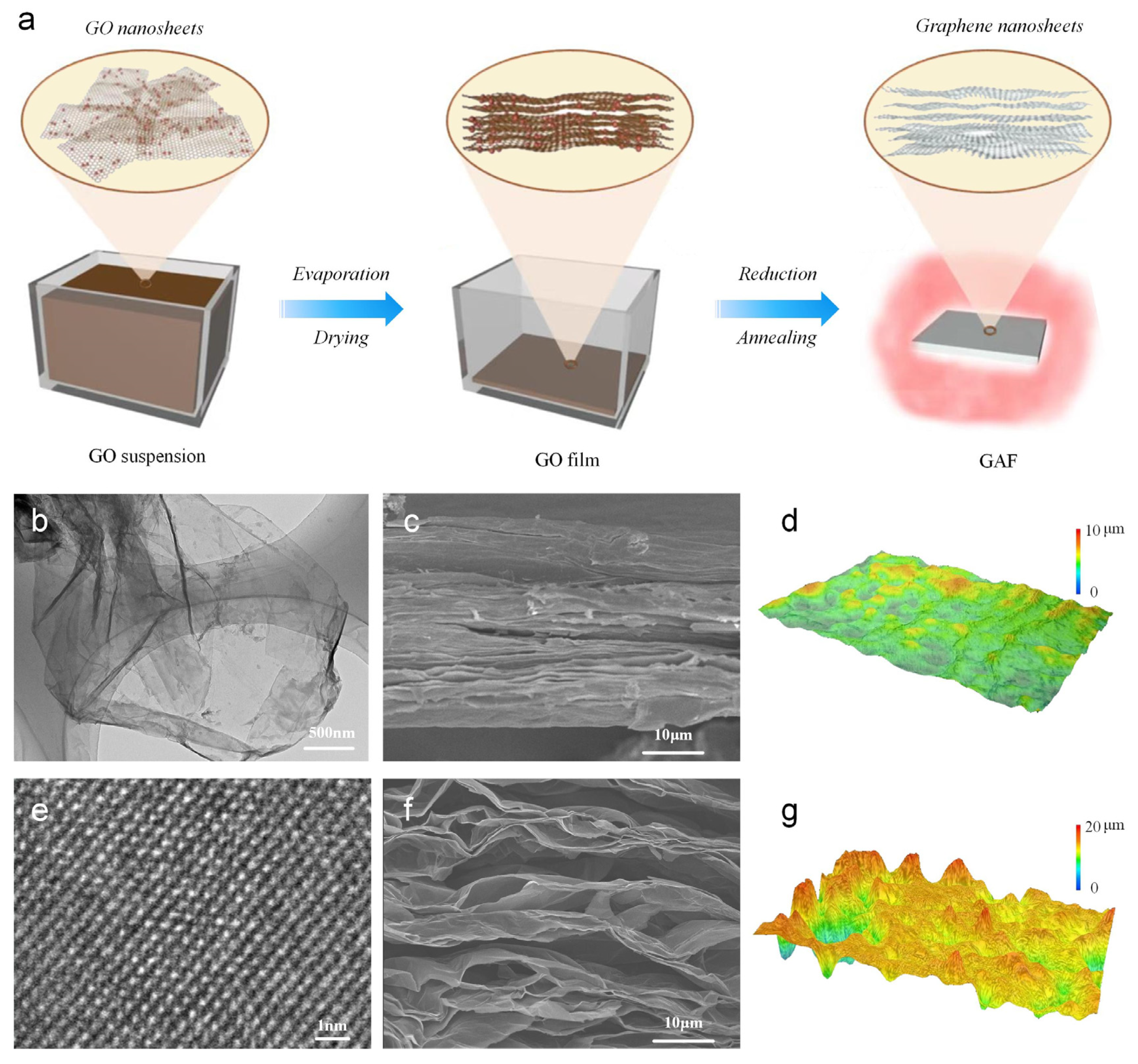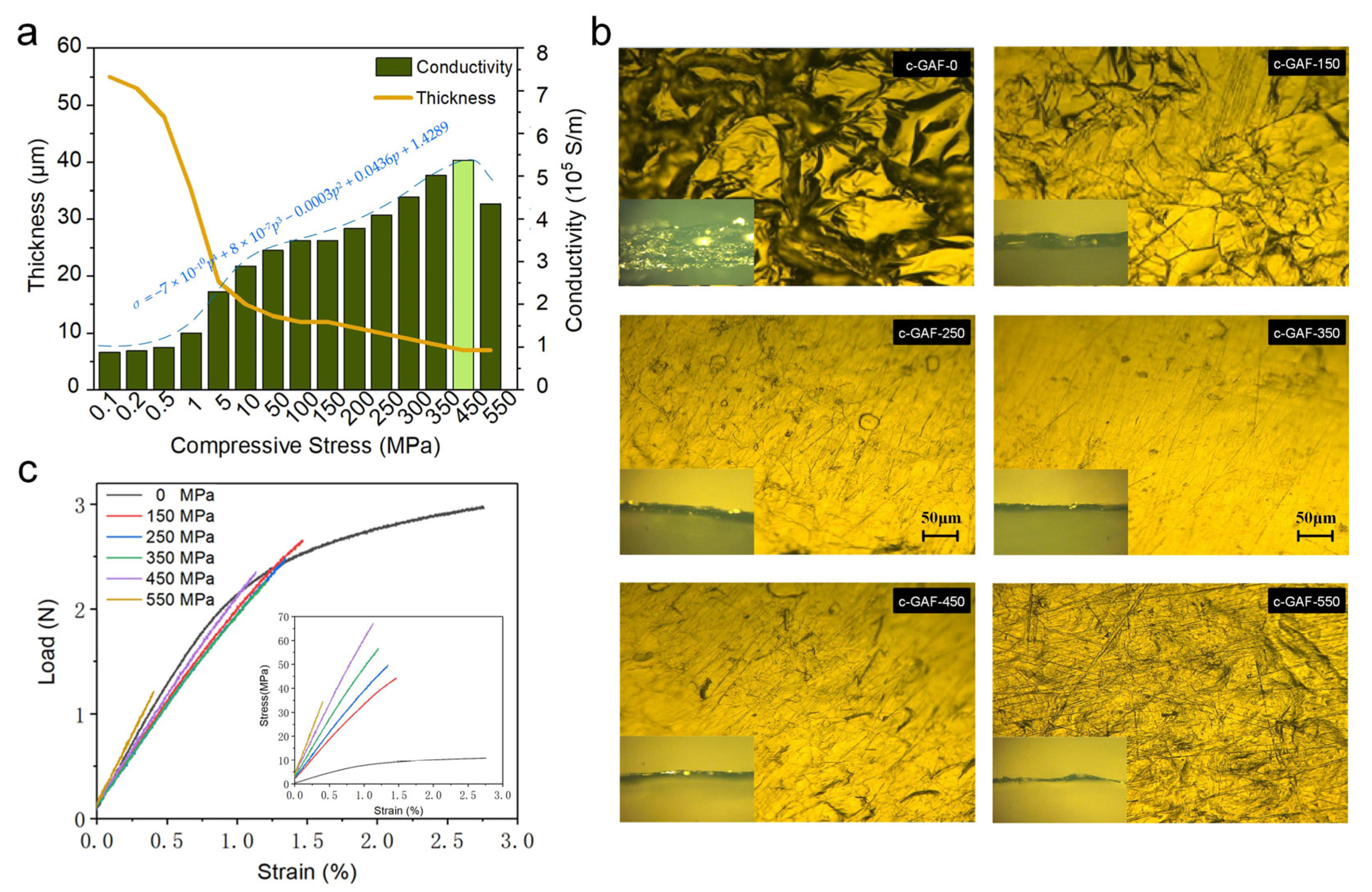Compressed Graphene Assembled Film with Tunable Electrical Conductivity
Abstract
1. Introduction
2. Materials and Methods
2.1. Preparation of GAF
2.2. Preparation of c-GAF
2.3. Characterizations
2.4. Tensile Test for c-GAF Strain Sensors
3. Result and Discussion
4. Conclusions
Author Contributions
Funding
Institutional Review Board Statement
Informed Consent Statement
Data Availability Statement
Acknowledgments
Conflicts of Interest
References
- Zhu, Y.; Murali, S.; Cai, W.; Li, X.; Suk, J.W.; Potts, J.R.; Ruoff, R.S. Graphene and Graphene Oxide: Synthesis, Properties, and Applications. Adv. Mater. 2010, 22, 3906–3924. [Google Scholar] [CrossRef]
- Geim, A.K. Graphene: Status and Prospects. Science 2009, 324, 1530–1534. [Google Scholar] [CrossRef] [PubMed]
- Thomale, R. Electronics tuned in twisted bilayer graphene. Nature 2020, 583, 364–365. [Google Scholar] [CrossRef] [PubMed]
- Castro Neto, A.H.; Guinea, F.; Peres, N.M.R.; Novoselov, K.S.; Geim, A.K. The electronic properties of graphene. Rev. Mod. Phys. 2009, 81, 109–162. [Google Scholar] [CrossRef]
- Fileti, E.E. Electric double layer formation and storing energy processes on graphene-based supercapacitors from electrical and thermodynamic perspectives. J. Mol. Model. 2020, 26, 159. [Google Scholar] [CrossRef] [PubMed]
- Mbognou, F.C.F.; Kenfack-Sadem, C.; Fotue, A.J.; Hounkonnou, M.N.; Akay, D.; Fai, L.C. Thermodynamics Properties and Optical Conductivity of Bipolaron in Graphene Nanoribbon Under Laser Irradiation. J. Low Temp. Phys. 2021, 203, 204–224. [Google Scholar] [CrossRef]
- Li, H.; Xiao, S.; Yu, H.; Xue, Y.; Yang, J. A review of graphene-based films for heat dissipation. New Carbon Mater. 2021, 36, 897–908. [Google Scholar] [CrossRef]
- Lv, L.; Dai, W.; Yu, J.; Jiang, N.; Lin, C.-T. A mini review: Application of graphene paper in thermal interface materials. New Carbon Mater. 2021, 36, 930–938. [Google Scholar] [CrossRef]
- Li, X.-L.; Guo, J.-G. Theoretical and numerical studies on the fracture properties of pre-cracked single-layer graphene. J. Phys. Chem. Solids 2020, 141, 109401. [Google Scholar] [CrossRef]
- Sheinerman, A.G. Modeling of structure and interface controlled strength of laminated metal/graphene composites. Mech. Mater. 2021, 158, 103888. [Google Scholar] [CrossRef]
- Shen, C.; Oyadiji, S.O. The processing and analysis of graphene and the strength enhancement effect of graphene-based filler materials: A review. Mater. Today Phys. 2020, 15, 100257. [Google Scholar] [CrossRef]
- Hekmatnia, B.; Naser-Moghadasi, M.; Khatir, M. Propagation length enhancement in a magneto optic plasmonic Mach-Zehnder isolator using graphene. Opt. Quantum. Electron. 2020, 52, 9. [Google Scholar] [CrossRef]
- Park, N.H.; Ha, S.; Chae, K.; Park, J.-Y.; Yeom, D.-I. Strong electro-optic absorption spanning nearly two octaves in an all-fiber graphene device. Nanophotonics 2020, 9, 4539–4544. [Google Scholar] [CrossRef]
- Teng, D.; Wang, K.; Li, Z. Graphene-Coated Nanowire Waveguides and Their Applications. Nanomaterials 2020, 10, 229. [Google Scholar] [CrossRef]
- Huang, H.; Shi, H.; Das, P.; Qin, J.; Li, Y.; Wang, X.; Su, F.; Wen, P.; Li, S.; Lu, P.; et al. The Chemistry and Promising Applications of Graphene and Porous Graphene Materials. Adv. Funct. Mater. 2020, 30, 1909035. [Google Scholar] [CrossRef]
- Grasseschi, D.; Silva, W.C.; de Paiva, R.S.; Starke, L.D.; Nascimento, A.S. Surface coordination chemistry of graphene: Understanding the coordination of single transition metal atoms. Coord. Chem. Rev. 2020, 422, 213469. [Google Scholar] [CrossRef]
- Ambrosio, G.; Brown, A.; Daukiya, L.; Drera, G.; Di Santo, G.; Petaccia, L.; De Feyter, S.; Sangaletti, L.; Pagliara, S. Impact of covalent functionalization by diazonium chemistry on the electronic properties of graphene on SiC. Nanoscale 2020, 12, 9032–9037. [Google Scholar] [CrossRef]
- Bai, L.; Zhang, Y.; Tong, W.; Sun, L.; Huang, H.; An, Q.; Tian, N.; Chu, P.K. Graphene for Energy Storage and Conversion: Synthesis and Interdisciplinary Applications. Electrochem. Energy Rev. 2020, 3, 395–430. [Google Scholar] [CrossRef]
- Ouyang, D.; Hu, L.; Wang, G.; Dai, B.; Yu, F.; Zhang, L. A review of biomass-derived graphene and graphene-like carbons for electrochemical energy storage and conversion. New Carbon Mater. 2021, 36, 350–368. [Google Scholar] [CrossRef]
- Sun, B.; Pang, J.; Cheng, Q.; Zhang, S.; Li, Y.; Zhang, C.; Sun, D.; Ibarlucea, B.; Li, Y.; Chen, D.; et al. Synthesis of Wafer-Scale Graphene with Chemical Vapor Deposition for Electronic Device Applications. Adv. Mater. Technol. 2021, 6, 2000744. [Google Scholar] [CrossRef]
- Yu, Q.; Jiang, J.; Jiang, L.; Yang, Q.; Yan, N. Advances in green synthesis and applications of graphene. Nano Res. 2021, 14, 3724–3743. [Google Scholar] [CrossRef]
- Rajput, N.S.; Al Zadjali, S.; Gutierrez, M.; Esawi, A.M.K.; Al Teneiji, M. Synthesis of holey graphene for advanced nanotechnological applications. RSC Adv. 2021, 11, 27381–27405. [Google Scholar] [CrossRef] [PubMed]
- Ikram, R.; Jan, B.M.; Ahmad, W. An overview of industrial scalable production of graphene oxide and analytical approaches for synthesis and characterization. J. Mater. Res. Technol. 2020, 9, 11587–11610. [Google Scholar] [CrossRef]
- Berrahal, Q.; Chacon, C.; Amara, H.; Bellec, A.; Latil, S.; Repain, V.; Rousset, S.; Lagoute, J.; Girard, Y. High density synthesis of topological point defects in graphene on 6H-SiC(0001). Carbon 2020, 170, 174–181. [Google Scholar] [CrossRef]
- Zhou, T.; Wu, C.; Wang, Y.; Tomsia, A.P.; Li, M.; Saiz, E.; Fang, S.; Baughman, R.H.; Jiang, L.; Cheng, Q. Super-tough MXene-functionalized graphene sheets. Nat. Commun. 2020, 11, 1–11. [Google Scholar] [CrossRef] [PubMed]
- Wan, S.; Chen, Y.; Fang, S.; Wang, S.; Xu, Z.; Jiang, L.; Baughman, R.H.; Cheng, Q. High-strength scalable graphene sheets by freezing stretch-induced alignment. Nat. Mater. 2021, 20, 624–631. [Google Scholar] [CrossRef]
- Li, P.; Wang, Z.; Song, R.; Qian, W.; Wen, P.; Yang, Z.; He, D. Customizable fabrication for auxetic graphene assembled macrofilms with high conductivity and flexibility. Carbon 2020, 162, 545–551. [Google Scholar] [CrossRef]
- Wen, Y.; Gao, E.; Hu, Z.; Xu, T.; Lu, H.; Xu, Z.; Li, C. Chemically modified graphene films with tunable negative Poisson’s ratios. Nat. Commun. 2019, 10, 2446. [Google Scholar] [CrossRef]
- Denk, R.; Hohage, M.; Zeppenfeld, P.; Cai, J.; Pignedoli, C.A.; Söde, H.; Fasel, R.; Feng, X.; Müllen, K.; Wang, S.; et al. Exciton-dominated optical response of ultra-narrow graphene nanoribbons. Nat. Commun. 2014, 5, 4–10. [Google Scholar] [CrossRef]
- Wu, H.; Gao, J.; Xiong, Y.; Zhu, Q.; Yue, Y. Tuning thermal conductance of graphene-polyethylene composites via graphene inclination and curvature. Int. J. Heat Mass. Transf. 2021, 178, 121634. [Google Scholar] [CrossRef]
- Barkov, P.V.; Glukhova, O.E. Holey graphene: Topological control of electronic properties and electric conductivity. Nanomaterials 2021, 11, 1074. [Google Scholar] [CrossRef]
- Ares, P.; Pisarra, M.; Segovia, P.; Díaz, C.; Martín, F.; Michel, E.G.; Zamora, F.; Gómez-Navarro, C.; Gómez-Herrero, J. Tunable Graphene Electronics with Local Ultrahigh Pressure. Adv. Funct. Mater. 2019, 29, 1806715. [Google Scholar] [CrossRef]
- Valcheva, E.; Kirilov, K.; Arnaudov, B.; Bundaleska, N.; Henriques, J.; Russev, S.; Tatarova, E. Electrical Conductivity of Free-standing N-graphene Sheets. In Proceedings of the 10th Jubilee Conference Balkan Physical Union, Sofia, Bulgaria, 26–30 August 2018; AIP Publishing LLC: Melville, NY, USA, 2019; p. 2075. [Google Scholar]
- Wang, Z.; Li, P.; Song, R.; Qian, W.; Zhou, H.; Wang, Q.; He, D. High conductive graphene assembled films with porous micro-structure for freestanding and ultra-low power strain sensors. Sci. Bull. 2020, 65, 1363–1370. [Google Scholar] [CrossRef]
- Qian, W.; Fu, H.; Sun, Y.; Wang, Z.; Wu, H.; Kou, Z.; Nan, C.W. Scalable Assembly of High-Quality Graphene Films via Electrostatic-Repulsion Aligning. Adv. Mater. 2022. [Google Scholar] [CrossRef] [PubMed]
- Song, R.; Wang, Z.; Zu, H.; Chen, Q.; Mao, B.; Wu, Z.P.; He, D. Wideband and low sidelobe graphene antenna array for 5G applications. Sci. Bull. 2021, 66, 103–106. [Google Scholar] [CrossRef]
- Zhao, X.; He, D.; You, B. Laser engraving and punching of graphene films as flexible all-solid-state planar micro-supercapacitor electrodes. Mater. Today Sustain. 2022, 17, 100096. [Google Scholar] [CrossRef]
- Yu, R.; Zhu, C.; Wan, J.; Li, Y.; Hong, X. Review of Graphene-Based Textile Strain Sensors, with Emphasis on Structure Activity Relationship. Polymers 2021, 13, 151. [Google Scholar] [CrossRef]




| Compressive Stress (MPa) | Thickness (μm) | Sheet Resistance (mΩ/sq) | Conductivity (105 S/m) |
|---|---|---|---|
| 0.1 | 55 | 206 | 0.88 |
| 0.2 | 53 | 206 | 0.92 |
| 0.5 | 48 | 209 | 1.00 |
| 1 | 35 | 213 | 1.34 |
| 5 | 19 | 229 | 2.30 |
| 10 | 15 | 230 | 2.90 |
| 50 | 13 | 235 | 3.27 |
| 100 | 12 | 238 | 3.50 |
| 150 | 12 | 238 | 3.50 |
| 200 | 11 | 240 | 3.79 |
| 250 | 10 | 244 | 4.10 |
| 300 | 9 | 246 | 4.52 |
| 350 | 8 | 249 | 5.02 |
| 450 | 7 | 266 | 5.37 |
| 550 | 7 | 328 | 4.36 |
Disclaimer/Publisher’s Note: The statements, opinions and data contained in all publications are solely those of the individual author(s) and contributor(s) and not of MDPI and/or the editor(s). MDPI and/or the editor(s) disclaim responsibility for any injury to people or property resulting from any ideas, methods, instructions or products referred to in the content. |
© 2023 by the authors. Licensee MDPI, Basel, Switzerland. This article is an open access article distributed under the terms and conditions of the Creative Commons Attribution (CC BY) license (https://creativecommons.org/licenses/by/4.0/).
Share and Cite
Chen, Q.; Wang, Z.; Jin, H.; Zhao, X.; Feng, H.; Li, P.; He, D. Compressed Graphene Assembled Film with Tunable Electrical Conductivity. Materials 2023, 16, 526. https://doi.org/10.3390/ma16020526
Chen Q, Wang Z, Jin H, Zhao X, Feng H, Li P, He D. Compressed Graphene Assembled Film with Tunable Electrical Conductivity. Materials. 2023; 16(2):526. https://doi.org/10.3390/ma16020526
Chicago/Turabian StyleChen, Qiang, Zhe Wang, Huihui Jin, Xin Zhao, Hao Feng, Peng Li, and Daping He. 2023. "Compressed Graphene Assembled Film with Tunable Electrical Conductivity" Materials 16, no. 2: 526. https://doi.org/10.3390/ma16020526
APA StyleChen, Q., Wang, Z., Jin, H., Zhao, X., Feng, H., Li, P., & He, D. (2023). Compressed Graphene Assembled Film with Tunable Electrical Conductivity. Materials, 16(2), 526. https://doi.org/10.3390/ma16020526








